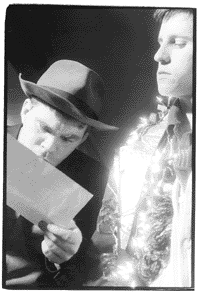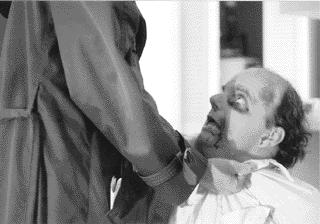https://www.austinchronicle.com/arts/1998-03-27/523079/
Exhibitionism
The Whimsy:dream on
March 27, 1998, Arts
Running Time: 1 hr, 20 min
 You open your eyes and it's like you've been pulled from another life. You've been dreaming. Much of the dream was strange -- set in a place you recognized yet was no place you have ever been, populated with an odd mix of people you knew: some part of your life now, some who have not been part of it for years, some who are dead -- but despite the many ways in which the dream was out of step with the waking world, what happened in it was so intense that it feels to you more real than the things that happened to you yesterday. You were alive in it, and so you cling to the dream, striving to hold onto its every baffling detail.
You open your eyes and it's like you've been pulled from another life. You've been dreaming. Much of the dream was strange -- set in a place you recognized yet was no place you have ever been, populated with an odd mix of people you knew: some part of your life now, some who have not been part of it for years, some who are dead -- but despite the many ways in which the dream was out of step with the waking world, what happened in it was so intense that it feels to you more real than the things that happened to you yesterday. You were alive in it, and so you cling to the dream, striving to hold onto its every baffling detail.
Most days it seems that nothing in the waking world can echo the wonders we enjoy in dreams. Where in this realm of the rational is the kind of fluidity of present and past, the casual transgression of physical laws, the hyper-reality, and most of all the captivating mystery that we know from our sleeping life? It seems you have to have a nap to find them.
Then, one evening you stumble up a flight of stairs in the heart of this relentlessly conventional city, and suddenly you find yourself deep in a dream. You're standing in a crowd, a few familiar faces, mostly strangers, and past you glides a woman in a rose-colored gown of another era. One arm is outstretched before her and in her trembling, pink-gloved hand is an envelope, at which she stares intently, with an expression of... what? Sorrow? Regret? Dread? Before you can determine which, she vanishes behind a curtain. Then, quickly, in her place appears a miniature proscenium stage and on it, conversing in a boat, two puppets: a bird with a long neck and long beak and fuzzy chin, and a fisherman, an old salt speaking with a Scots burr and sporting an open pocket watch where one eye should be. They talk of their great affection for one another, their enduring friendship, then they too disappear. The stage is folded up and carried away, and the crowd of which you are a part is ushered past the black curtain into a space containing a row of waist-high buildings and a sky of black velvet speckled with shining stars and, wearing a sparkling sleeveless gown and a glittering silver turban and a luminous smile, the Moon.
This is the world of The Whimsy, and it lives in the way a dream lives -- in a space we know yet don't know, out of time yet in it, full of the fantastic and peculiar and enigmatic -- and it has a dream's vivid wonders to share. Physical Plant Theater Artistic Director Steve Moore, with assistance from nine other artists, has written a fanciful romance full of talking animals, singing moons, mystery women (and men), and other unconventional figures who
belong to the surreal reality of dreams. In 22 very brief scenes, he engages them in actions mundane and majestic, from the reading of a letter to a voyage to the bottom of the sea. The scenes are rife with oddities and absurdities, symbols and non sequiturs, abrupt transitions and humorous juxtapositions, which add to the atmosphere of unreality, but those
qualities alone aren't enough to make these scenes dreamlike. We get that sense from the way that every action, every line, however weird or disjointed, fits. In The Whimsy, as in dreams, we sense that whatever is happening is what ought to be happening. All is as it should be.
Credit for that sensibility, however, belongs to all the artists contributing to the production. The actors imbue their characters, even the most puzzling, with some inner purpose. We may not be told why, for instance, the trench-coated Smith and Wesson come looking for the letters that the Pink Lady deposits in an onstage mailbox, but Hank Cathey and James Hegberg make us believe they have a reason, and their reactions to the missives they find seem to develop credibly from whatever it is. Likewise, the story of the Pink Lady is never revealed to us, but Amy Dickson's expressive face and gestures convey a profound pain that is enough to justify her mysterious behavior. Perhaps more impressively, the puppeteers manage the neat trick of giving their charges a rich inner life. From Cathey's Yardbird, who nobly braves ocean terrors to rescue his dear friend, to Avi Hartman's clock-eyed Fisherman, trapped and forlorn, to Dickson's lonely, wistful Fishwife, an impossibly poetic creature with a skeleton's head that has roses blooming in her eye sockets, we feel as deep a humanity as in anyone we know.
The environment in which these figures move is one to which we can feel they belong. Brad Wilson's dollhouse cityscape and sky are a setting of childhood possibility, one open to enchantment. Larry Aquaviva's sound effects build on that sense of youthful imagination and play. And Carlos Treviño's music, playfully
rendered by Treviño on piano, Aquaviva on drums, and Jesse Canterbury on clarinet, underscore the fancy of Moore's script and depth of feeling in the performances. His use of a stately rag for the Pink Lady's deeply felt promenades, enhanced their poignance.
In many ways, this is a world that ought not to appeal -- it's incredible and elliptical and self-conscious, and its stories are fragmented and fraught with symbolism, but so are the worlds in dreams. And how often do we wake from a dream and wish we could return to it, to its nonsense and illogic and metaphor? So it is with the world of The Whimsy. It ended and I ached to return, as did my five-year-old daughter. It's a rare thing to find that in the waking world. To Steve Moore and the artists of this production, foremost among them director Katie Pearl, whose name is surely a metaphor of some kind, congratulations in realizing a dream. -- Robert Faires
FLAME FAILURE, EPISODE 11: THE MAN BEHIND THE DUSTCOVER: RECOVERED MOMENTUM
The Public Domain Gallery, through March 29
Running Time: 50 min

Now we are left with a handful of survivors, a few last ruddy souls who have become hardened with the ongoing struggle. The boundaries are blurred, the questions are more nebulous. Which side are you on? Are you still in the quest? Do you even know the game is afoot? The answers have no meaning because the data can change with one misplaced word or blood-soaked
admission. When you get right down to it, though, these questions hold true for the production team who has been with this event for the last year as well as for this installment, in which characters continually change alliances and the sides lose cohesion.
The Man Behind the Dustcover, the penultimate episode of this serialized dark espionage thriller, is tinged with the same pre-millennial fever that also has the country by the throat. The reins have been loosened a bit because the end is in sight. Let's party like it's 1999. The wheel of time's velocity has been imperceptibly increasing, and the production tries to cram in every last thing the creators have ever wanted to do before they are flung off the wheel and it stops spinning.
Those who have been grabbed by the momentum of Flame Failure realize that its time is growing short, a relief probably for the Downstage Players, who have spent the past year producing one play a month in the Public Domain basement. It's also a relief for the actors, some of whom have also devoted months of their lives to this ambitious project, and for the audience, all of whom want to know who has the damn Book, the tome that contains ultimate knowledge and has been the object of much tooth-gnashing over the past 11 months. But the audience also benefits from the approaching end. Everything has been turned up a notch, like the world before the dawn of a new era. Everything has become a little faster, a little sharper, and a lot more fun.
Performances are what really make thisepisode a speedy, exciting trip through writer-director Dan Bonfitto's underworld. Craig Kanne is hysterical as the Book's author, full of surprises and able to fully convey each and every one with his droll voice and mild-mannered appearance. Anne Engelking and Alvin Cantu are delightful as the Anaconda's thugs, willing to break a few kneecaps or poke a few wounds if it will get the job done. Walter Clark has honed Drake, a
character that has been with the saga since its fiery beginnings, into a layered figure, vulnerable yet convicted. And Bernadette Nason fills Gail, the queen of covert ops, with sharp wit and gusto.
For those who have been oblivious to Flame Failure, now would be a perfect time to get in on the adventure. Problems with apathy and exhaustion that plagued the middle episodes have been solved with the looming finale. The show's perpetual feeling of vital uniqueness has been distilled into a sharp, potent episode that starts to answer some pretty important questions and shows us who will ultimately survive. -- Adrienne Martini
Copyright © 2024 Austin Chronicle Corporation. All rights reserved.
